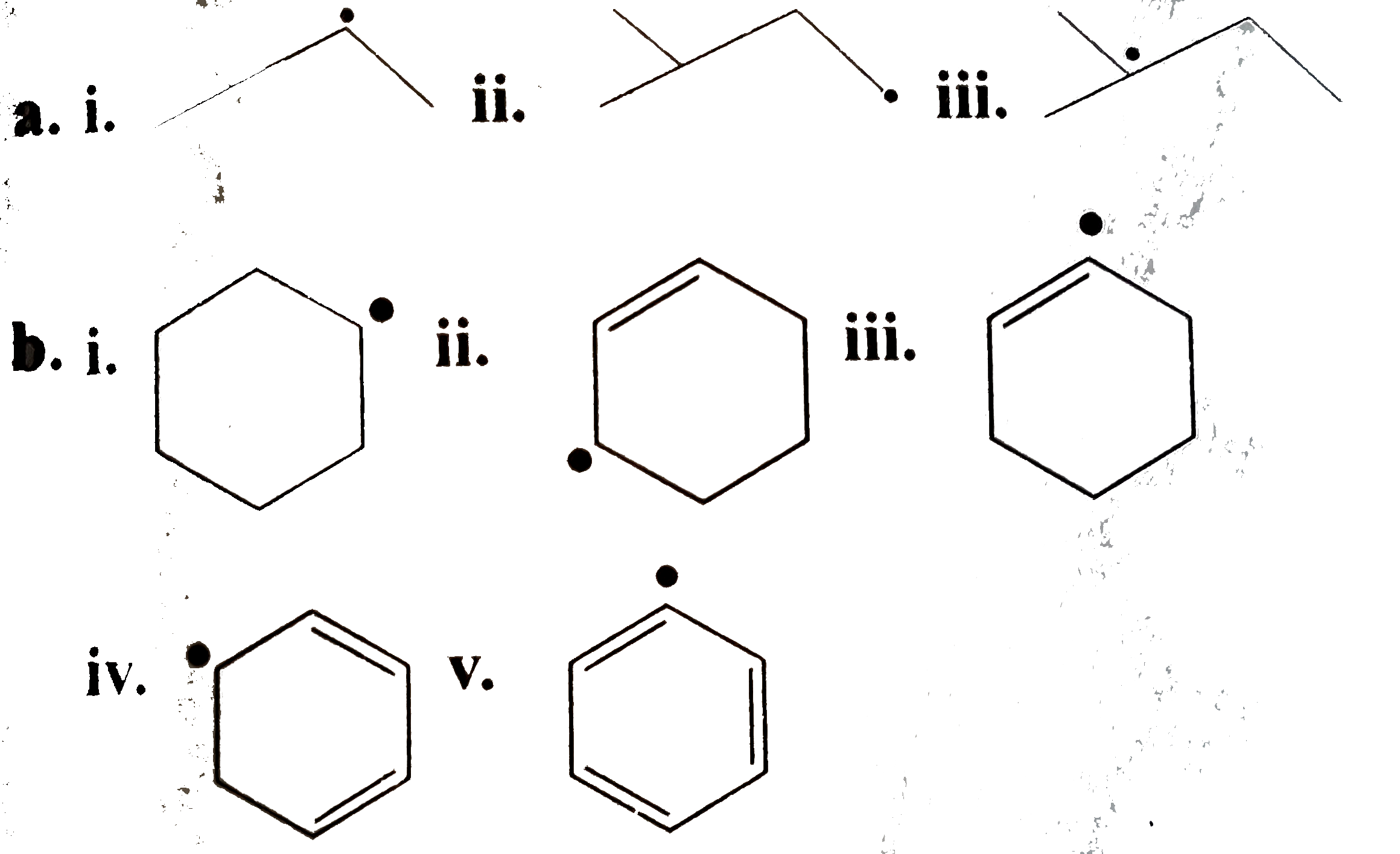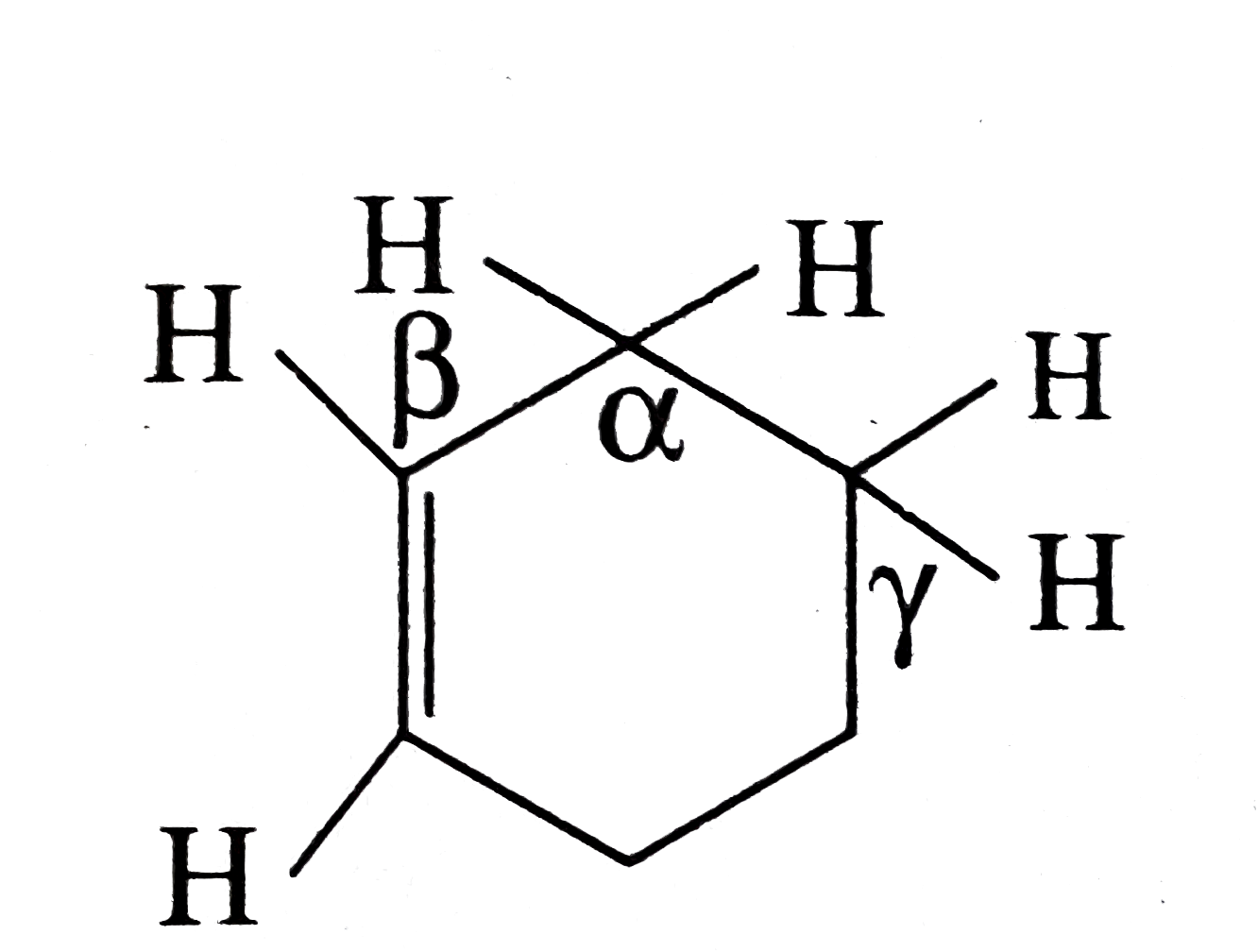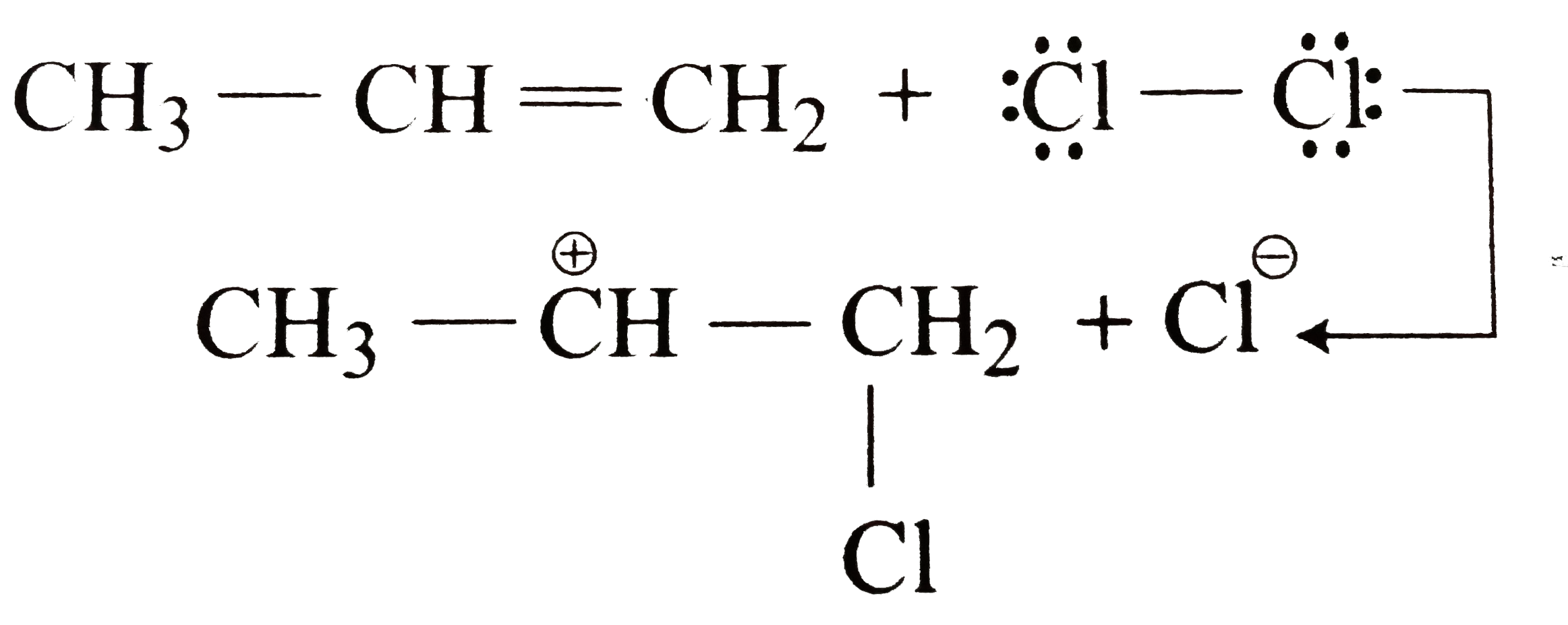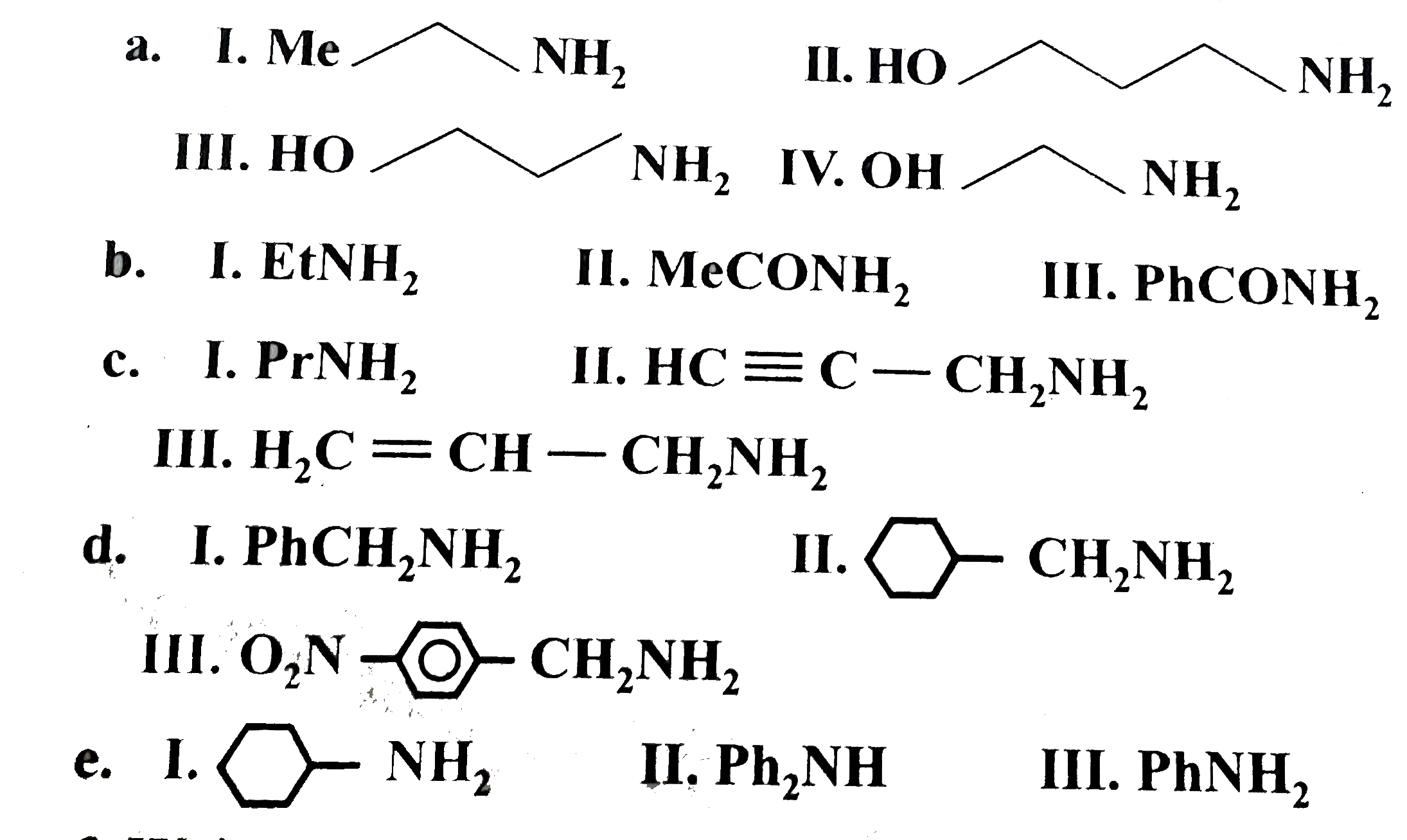Complete Solutions to Illustration of chapter GENERAL ORGANIC CHEMISTRY of Class 11 book with complete answers and questions
| Class 11 | CHEMISTRY |
| Chapter | GENERAL ORGANIC CHEMISTRY |
| CENGAGE CHEMISTRY | Illustration |
| Number Of Questions | 22 |
| Academic Year | 2023-24 |
Determine the `F.C` on each atom in :
(a) `HOBr`
(b) `overset (oplus)N H_4`
( c) `H_2 O : B B r_3`.
View Solution(a) Draw Lewis structures for :
(i) Ethanol `(C_2 H_5 O H)`
(ii) `BrNO`
(iii) `HOCN`
(iv) `NH_2 OH` (Kydroxylamine).
(b) Give an isomeric structure for `NH_2 OH` and explain which structure is more stable.
View SolutionWith the help of `F.C`. Explain which Lewis structure is more stable for the following molecules :
(a) `N_(2)O: (i) :^(Theta)ddotN =overset(2+)O=ddotN:^(Theta) or (ii) :N -=overset(o+)N-ddotunderset(..)O:^(Theta)`
(b). `H_(2)SO_(4): (i) H-O-overset( :ddotO:^(Theta))overset(|)underset(Theta)underset( :underset(..)O: )underset(|)(S^(+2))-O-H or (ii) H-O-underset( underset(..):O)underset(||)overset(ddotO: )overset(||)S-O-H`
`HNO_(3)(i) H-O-underset(Theta)underset( :underset(..)O: )underset(|)overset(o+)N=ddotO: or (ii) H-O-underset(underset(..):O:_(Theta))underset(|)overset(+2)N-underset(..)ddotO:^(Theta)`
(d). `CI_(2)O: (i) underset(..):ddotCI-ddotunderset(..)O-underset(..)ddotCI: or (ii) :underset(..)ddotO-underset(..)ddot(CI)-underset(..)ddotCI:`
View SolutionDetermine `F.C` on each atom in
(a) carbocation `H_3 O^(oplus)`
(b) carbanion `H_3 C^(ӫ)`
( c) free radical `H_3 C^.`
(d) carbene `H_2 C :`.
View SolutionExplain whether oxidation, reductio, or neither occurs in the following reactions :
(a) `H_2 C= CH_2 rarr H_3 C - CH_3`
(b) `HC -= CH rarr H_3 C- CH = O`
( c) `CH_4 rarr CH_3 OH`
(d) `H_2 CB r_2 rarr H_2 C = O`
II. Give the structural formula for the simplest hydrocarbon in which `C` has a zero `O.N`.
View SolutionExplain :
(i) `mu of NH_3 gt NF_3`
(ii) `mu of CH_3 C1 gt CH_3 F gt CH_3 Br gt CH_3 I`
(iii) `mu of CO_2` is zero, nut `mu of SO_2 ne 0`
(iv) Why the lone pair of `overline e^, s` has no effect on the `mu` of `PH_3`. The bond angle in `PH_3` is `92^@`.
(v) `mu of CH_2 C1_2 gt CH C1_3`.
View SolutionDescribe heterolytic (polar) bond cleavage of :
(i) `Agl`,
(ii) `H_3 overset (oplus)N overset (Ө)B F_3`,
(iii) `[Cu (OH_2)_4]^(2 oplus)`
(b) Name the reverse of heterolytic cleavage.
( c) Describe homolytic bond cleavage of `CH_3 - Co- Co- CH_3`.
(d) Compare the relative energies of singlet and triplet carbenes.
( e) Of `X_ C` : (singlet) and `X_2 C` : (triplet), which is stable ?
(f) Of `F_2 C :, C 1_2 C :, Br_2 C :, I_2 C `: (singlet), which is more stable ?
(g) Compare and explain the difference in the `IE` and `EA` of `*CH_3`.
View SolutionGive the decreasing order of the stabilities of the following :



View SolutionClassify the following species as
(a) nuclephile,
(b) electrophile,
( c) both, or
(d) neither.
(1) `overset (oplus) N O_2`
(2) `RCH =0`
(3) `H_2`
(4) `SnF_4`
(5) `R - C -= ddot N`
(6) `CH_4`
(6) `Cr^4`
(7) `Cr^3`
(8) `BeF_2`
(9) `ddot N H_3`
(10) `I^(Ө)`
(11) `RCOO^(Ө)`
(12) `C_2 H_5 O^(Ө)`
(13) `BC1_3`
(14) `Br^(oplus)`
(15) `Br_2 C :`
(16) `SiC1_4`
(17) `Me_3 ddot P`
(18) `Me_2CH^(oplus)`
(19) `CH_2 = CH_4`
(20) `HC1`
(21) `Me_3 C^(ddot Ө)`.
View SolutionName the intermediate species formed in the following reactions :
(a) `CH_3 CH_2 - underset (oplus) N -= underset (ddot) N rarr I + :N -= N:`
(b) `CH_3 CH_2 -C -= C- H + overset (oplus)K overset (Theta)N H_2 rarr II + NH_3`
( c) `Ph -CH = CH - Me + HBr rarr III + Br^(Ө)`
(d) `Ph-overset(Ph)overset(|)underset(OH)underset(|)(C)-CH_(3)+H^(o+) rarr IV +H_(2)O`
( e)`CH_3 CH_2 underset (ddot) overset (ddot) O H overset (-overlinee)rarr V rarr VI + .CH_3`
(f) `CH_3-ddot(N) =ddot(N) -CH_(3) overset(Delta)rarr VIII +ZnI_(2)`
(h) `PhCH_2C1 + A1C1_3 rarr IX + [A1C1]^(Ө)`
(i) `CH_3 - C -= C - CH_3 + Li underset (C_2H_5 OH) overset (liq. NH_3)rarr X + Li^(oplus)`.
View SolutionDesignate the species (A) and (B) as electrophile ( E) or nucleophile (Nu) in the following reactions :
(a) `BEt_(3) +Me_(2)ddotO:rarrMe_(2)overset(o+)underset(..)(O)-overset(Theta)BEt_(3)`
(b) `CH_(2) =O +underset("Bisulphite ion")( :overset(Theta)SO_(3)Hrarr)underset(O^(Theta))underset(|)(CH_(2))-SO_(3)H`
( c) `C_2H_5C1 + :CH:^(Ө) rarrC_2H_5 -CN + C1^(Ө)`
(d)
( e) `CH_(3)-overset(o+)(CH)-underset(CI)underset(|)(CH_(2)) +CI^(Theta) rarr CH_(3) -underset(CI)underset(|)(CH)-underset(CI)underset(|)(CH_(2))`
(f) `:underset(..)overset(o+)NH_(2) +CH_(3)-C-=CH rarr CH_(3)-C -= C^(ddotTheta) +NH_(3)`
View SolutionGive the decreasing order of acidic character.
(1) `NO_2CH_2 OH`,
(b) `C1CH_2COOH`,
(c) `HCOOH`,
(d) `CH_3 COOH`,
( e) `CH_3 OH`
(2) (a) `RCOOH`
(b) `ROH`
( c) `H_2 O`
(d) `NH_3`
( e) `CH -= CH`
(f) `RH`
(3) (a) `HCOOH`
(b) `PhOH`
( c) `CH_3OH`
(d) `C_2 H_5OH`
( e)`CH_3 C -= CH`
(f) `CH -= CH`,
(g) `NH_3`
(4) (a) `CH_3COOH`
(b) `H_3O^(oplus)`
( c) `H_2O`
(d) `C_2H_5 COOH`
( e) `NH_3`
(f) `CH -= CH`
(g) `CH_2 = CH_2`
(h) `CH_4`
(i) `C_2 H_6`.
(5) (a) `H_2 O`
(b) `CH_3OH`
( c) `RC -= CH`
(d) `H_2`
( e) `NH_3`
(f) `RH`
(g) `ROH`
(6) Basic character of conjugate base of Problem `5`.
View SolutionArrange the following :
(a) In decreasing order of `p K_b` values
(I) `C_2H_5 NH_2`
(II) `PhNHMe`
(III) `(C_2H_5)_2 NH`
(IV) `PhNH_2`
(b) In increasing order of basic strength
(I) `PhNH_2`
(II) `PhNM_(e_2)`
(III) `(C_2H_5)_2 NH`
(IV) `MeNH_2`
( c)Increasing order of basic strngth (I) `PhNH_2`
(II) `p-`Nitroaniline
(III) `p-`Toluidine
(d) (I) `PhNH_2`
(II) `PhNHMe`
(III) `PhCH_2NH_2`
( e) In decreasing order of basic strength in gas phase.
(I) `C_2H_5 NH_2`
(II) `(C_2H_5)_2NH`
(III) `(C_2H_5)_3N`
(IV) `NH_3`.
View SolutionArrange the following in decreasing order of basicities :

(f) Write the conjugate base and conjugate acid of `(I) HOCH_2 CH_2 NH_2`.
View SolutionWhich of the following pairs do not constitute resonance structures ?

View SolutionArrange the following resonating structures in the order of decreasing stability :
(a) `underset(("Vinyl chloride"))underset((I))(CH_(2)=CH-ddotunderset(..)CI: )harrunderset((II))( :overset(Theta)(CH_(2))-CH=overset(o+)underset(..)CI: )harrunderset((III))(overset(o+)CH_(2))-CH=underset(..)ddotCI^(Theta)`
b. `underset(("Formic acid"))underset((IV))(H-overset(ddotO: )overset(||)C)-underset(..)ddotOH harrunderset((V))(H-overset( :ddotO:^(Theta))overset(|)(C)=underset(o+)ddotO)-H harrunderset((VI))(H-overset( :ddotO:^(Theta))overset(|)underset(o+)(C)-underset(..)ddotO-Hharr) underset((VII))(H-underset(ddotTheta)overset( overset(o+):O: )overset(|)C-underset(..)ddotO-H)`
( c) Write the resonating structure of phenol in order of decreasing stability.
View Solution(a) Write the resonance structures of `NO_2^(Ө)` (nitrite) and `NO_3^(Ө)` (nitrate ion) in terms of :
(i) outer shell `overline e^, s` with formal charges
(ii) overlapping atomic orbitals.
( c) Compare the resonance (delocalisation) energy adn stabilities of `NO_2^(Ө)` and `NO_3^(Ө)`.
(b) (i) Write the resonance contributing and hybrid structures of (I) `N_2 O` (II) `H_2 C - N_2` (diazomethane).
(ii) Give the hybridised state of each atom in each structure.
(iii) Discuss their bond length in each resonance contributing structure and compare with those in hybrid structures.
View Solution(a) Which `N` of guanidine `(I)` is more basic and is more likely to be protonated ?
(b) Why guanidine is the strongest organic `N-base` `(K_(b) ~= 1)` ?
( c) Why amides `(III)` are weakly basic (amphoteric), whereas phthalimide `(IV)` is an acid ?
View SolutionCompare the stabilities of the following pairs of resonance contributing structures and explain how the hybrid structure is related to the structures.
(a) `R-underset((I))overset(o+)(C)= ddotO: harrR-C=overset(o+)ddotO:underset((II))(("acylium ion"))`
(b) `underset((III))(Me-overset(o+)underset( underset(..)( :O)^(ddotTheta))underset(|) ddot(S)-Me)harrunderset((IV))(Me-underset(underset(..)( :O))underset(||)(ddotS)-Me)`
(c) `underset((V))(Me_(2)C=underset(Me)underset(|)(C)-overset(o+)ddotO:harr)underset((VI))(Me_(2)overset(o+)(C)-underset(Me)underset(|)(C)=overset(o+)ddot(O: )`
(d) `underset((VII))(H_(2)C=ddotO:harr)underset((VII))(H_(2)overset(o+)C)-ddotO:^(Theta)`
(e) `underset((IX))(Me-overset(ddotTheta)(CH)-underset(underset(..)O: )underset(||)(C)-Me harr )underset((X))(Me-CH=underset( underset(..):O:^(Theta))underset(|)(C)-Me)`
(f). `underset((XI))(CH_(2)-CH_(2))harroverset(o+)underset((XII))(CH_(2))-overset(ddotTheta)CH_(2)` (g). `underset((XIII))(R-underset(underset(..):O:^(Theta))underset(|)(C)=overset(o+)underset(..)(OH)harr)underset((XIV))(R-underset(underset(..)( :O))underset(||)(C)-overset(..)underset(..)OH)`
View Solution(a) Give the decreasing order of stabilities of the following alkenes :
(i) Ethene,
(ii) Propene,
(iii) `cis-2-`butene
(iv) trans-2-Butene
(v) `2-`Methy1-2-butene,
(vi) `2,3-`Dimethy1-2-butene
(b) Give the decreasing order of reactivity of the above alkenes.
( c) Give the product of the following reaction :
`Me_(2)CHCH_(2)CH_(2)OH overset("Dehydration")underset("Conc"H_(2)SO_(4)(160-170^(@)C))rarrunderset(-H_(2)O)(A)`
View Solution(a) Give the resonance structure of the conjugate bases of the following :

(b) Compare the stabilities of their bases and the acidites of the parent compounds.
View SolutionGive the decreasing order of acidities of :
(a) (I) `H_(3)C-overset(O)overset(||)(C)-OMe` (II) `H_3 C - CH = O`
(III) `H_(3)C-underset(O^(Theta))underset(|)overset(o+)(N)=O` and explain.
(b) Give the factors that affect relative basicities.
View Solution
Illustration questions and complete solutions for chapter GENERAL ORGANIC CHEMISTRY of CENGAGE CHEMISTRY (HINGLISH) of Class 11